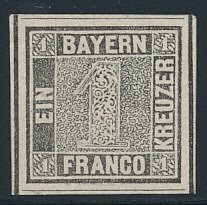
The country that is today called Germany is a recent political construction. Indeed, even in the last twenty or so years the borders have been in flux with the reunification of the GDR into the Bundesrepublic. Much of the history of Europe over the last 300 years has been concerned with the drawing of Germanic borders and this is reflected in German philately of the nineteenth century. Germany was not one nation in the early philatelic period, rather a group of autonomous states each with its own ruling families and which were often antagonistic towards each other. Seventeen independent German nations issued stamps which are today listed in the Scott catalog under the heading German States. Perhaps the most popular stamp of all the hundreds of the German States issues is the first stamp of Bavaria issued in 1849. It is one of the scarcer stamps of the world and as with most German States has been forged often (in the case of Bavaria #1 there are over twenty different forgeries). The reason for the plethora of German State forgeries is that by 1870 Germany had consolidated and was one political unit. The stamps of the various component states were demonetized and because they had no postage value and were from nonexistent political entities the forging of the stamps no longer represented the crime of depriving the state of revenue but rather of defrauding collectors and was less fiercely policed. German unification in 1870 not only destabilized Europe but it destabilized philately as well.
Shopping Cart
